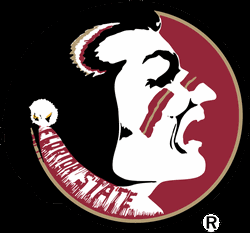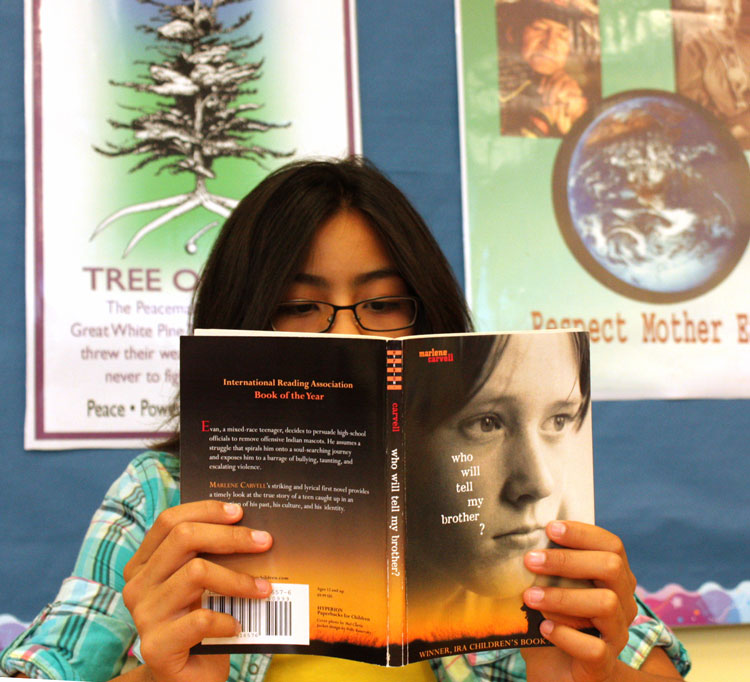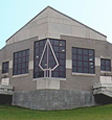





Who Will Tell My Brother?
Wadeñ nwa aweñha
May 29, 2012
Wadeñ nwa aweñha
May 29, 2012
Onondaga Nation – In Mr. Bradley Powless’ Onondaga history class, the 7th graders learned about the history of native mascots in sports. The class read about the role the Onondaga Nation Council of Chiefs had in the changing of the Syracuse University’s mascot, known then as The Saltine Warrior, and the opposition it raised in the 1970’s. As Syracuse Alumni Oren Lyons said about the Saltine Warrior, “It is difficult to feel like you are being honored and respected when you’re wrestling a goat on the 50 yard line.”
“I think that it is important for our children to be aware of some of the ideas that people h ave about natives in general,” said Mr. Powless. “The native logo and mascot debate is a great place for our students to be able to discuss both sides of the issue, and recognize their role in changing that perception.”
ave about natives in general,” said Mr. Powless. “The native logo and mascot debate is a great place for our students to be able to discuss both sides of the issue, and recognize their role in changing that perception.”
“I think that it is important for our children to be aware of some of the ideas that people h
 ave about natives in general,” said Mr. Powless. “The native logo and mascot debate is a great place for our students to be able to discuss both sides of the issue, and recognize their role in changing that perception.”
ave about natives in general,” said Mr. Powless. “The native logo and mascot debate is a great place for our students to be able to discuss both sides of the issue, and recognize their role in changing that perception.”The class reviewed many of the collegiate and professional logos of various sports teams. The students read about the annual protest of the Cleveland Indians home opener and the reaction it causes. Although a couple of the logos some of the kids thought looked “cool”, most saw the mascots as unflattering, and not representing who they were as native people. As one student said of the Florida State University logo, “Why does he have bacon on his face?”
Mr. Powless’ class further explored the role of mascots in high school by reading a book by Marlene Carvell titled “Who Will tell My Brother?”. The book chronicles the  life of Evan, a high school senior of Mohawk heritage, who tries to change the native logo at his school. Evan encounters obstacles in his journey and finds little support for his cause throughout his senior year.
life of Evan, a high school senior of Mohawk heritage, who tries to change the native logo at his school. Evan encounters obstacles in his journey and finds little support for his cause throughout his senior year.
As one student reacted during the reading, “I just want to jump in the book to help him.”
 life of Evan, a high school senior of Mohawk heritage, who tries to change the native logo at his school. Evan encounters obstacles in his journey and finds little support for his cause throughout his senior year.
life of Evan, a high school senior of Mohawk heritage, who tries to change the native logo at his school. Evan encounters obstacles in his journey and finds little support for his cause throughout his senior year. As one student reacted during the reading, “I just want to jump in the book to help him.”
The high school in which the story takes place is just 40 miles east of the Onondaga Nation. The students wrote to the author and expressed their feelings about her story and how mascots make them feel. Especially since this story's setting was based so close to home.
“This story could definitely help me in the future,” said a female student. “This book shows to be proud of my culture and to continue to learn about who we are.”
“This story could definitely help me in the future,” said a female student. “This book shows to be proud of my culture and to continue to learn about who we are.”
 Marlene Carvell wrote back to Mr. Powless’ class by explaining that the book is fiction but based on her own son Adam’s senior year. She also enclosed a photo of the mascot that inspired her son to take action. She also added, “While it is not always possible to write a personal response to the letters I receive, I must admit that your letters touched my heart.”
Marlene Carvell wrote back to Mr. Powless’ class by explaining that the book is fiction but based on her own son Adam’s senior year. She also enclosed a photo of the mascot that inspired her son to take action. She also added, “While it is not always possible to write a personal response to the letters I receive, I must admit that your letters touched my heart.”The theme expressed throughout Who Will Tell my Brother is that mascots do little to honor a people, but often continues Hollywood stereotypes. Often native mascots portray a people as either fighters, noble, or having red skin without honoring the real history and people of their area.
“After hundreds of years, there are still people out there who don’t know about us,” said another student. “I want people to know I am a human being too! Not a mascot."
Click to hear Mr. Powless’ 2010 class discussion about mascots.





